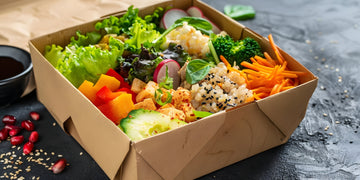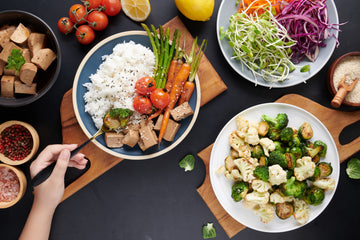Salads have long been linked with “health food." But choosing the right salad goes far beyond tossing a few greens into a bowl. Not every salad automatically qualifies as a power-packed, nutritious meal. To truly support a healthy eating journey, choose salads that feature a balance of fresh produce, high-quality proteins, nutritious fats, and flavorful dressings. This guide explores how to select healthy salads that satisfy your taste buds, your busy lifestyle, and your body’s nutritional needs.
Why Salads Are Nutritional Powerhouses?
A well-constructed salad isn’t just “diet food.” The right salads provide substantial nutrition: fiber for digestion, antioxidants for cell health, plant-based proteins for strength, and vitamins to support overall wellness. By crafting or choosing a salad thoughtfully, you can enjoy healthy dishes that will help you reach your health goals.
1. Start with a Fresh and Flavorful Base
The foundation of any healthy salad is its greens, which bring freshness, fiber, and micronutrients. Mix things up for maximum benefit:
-
Leafy greens, including spinach, kale, arugula, Swiss chard, and romaine, are rich in iron, vitamin K, and antioxidants.
-
Herbs: Sprinkle parsley, cilantro, or basil over the dish for an extra touch of flavor and minimal calories.
-
Vibrant veggies: Bell peppers, cherry tomatoes, shredded carrots, radishes, and beets add color (and carotenoids).
Look for fresh salads that keep produce crisp and bright. Greens that are wilted will not provide the same level of nutrition or taste.
2. Get Creative with Vegan and Plant-Based Ingredients
Vegan salads allow you to load up on diverse ingredients that go beyond basic lettuce. Plant-based proteins (like beans, lentils, and tofu) can make your salad filling and healthy:
-
Lentils and beans: Contain a high level of fiber and protein, making them ideal for maintaining heart health and regaining muscle mass.
-
Tofu and tempeh: Excellent, complete vegetarian protein sources.
-
Whole grains: Add quinoa, brown rice, or farro to make salads more satisfying and provide slow-release energy.
Try including different cooked and raw components for a balanced salad.
3. Rethink Protein and Add Texture
The best high-protein salads offer a variety of textures and substantial proteins to keep you full. Besides vegan options, lean proteins like grilled chicken or shrimp are also excellent salad additions for those not strictly plant-based.
Salads combining protein with nuts (like almonds or walnuts), seeds (chia, pumpkin, sunflower), and legumes are true nutritional winners. They contain a high amount of protein, healthy fats, minerals, and crunch.
4. Dress for Success the Healthy Way
Dressings can enhance a salad's nutritional status if they are used correctly. Choose homemade or thoughtfully crafted dressings featuring:
-
Healthy fats such as olive oil, avocado oil, and tahini help the body absorb vitamins.
-
Acidic components: Lemon, vinegar, or balsamic to brighten flavors and provide antioxidants.
-
Herbs and spices: Not only do they add flavor, but they also possess anti-inflammatory properties.
Beware of store-bought dressings high in added sugar, sodium, or artificial additives.
5. Explore Global Flavors & Diverse Ingredients
Salads don’t have to be boring or repetitive. The most Fresh and Flavorful Salads pull inspiration from global kitchens, mixing spices, grains, and unique dressings for each day of the week:
-
Try a French Lentil Salad with Cumin Balsamic Dressing. Lentils offer protein and iron, and cumin’s antioxidants pair perfectly.
-
Try Black Eyed Pea Salad with Mustard Dressing for a plant-based, Southern-inspired meal.
-
Love bold tastes? Choose the Burmese Salad with Chimichurri Dressing. Chimichurri packs herbs and healthy olive oil, while legumes add staying power.
By rotating your ingredient choices, you can enjoy a wide array of flavors and nutrients that will keep you satisfied and excited about your next meal.
6. Make salads for Main-Event Meals
Contrary to the old notion that salads are mere sides, today’s options can easily serve as the best salads in San Francisco. There is enough substance in them to serve as lunch or dinner. Combine vibrant base greens, colorful veggies, satisfying proteins, healthy grains, and nutrient-dense dressings for salad “bowls” that fill you up and fuel your day.
7. Go to Whole Foods and Organic, Where Possible
If you’re seeking the most nutritious foods, choose salads with organic, whole-food ingredients. Organic produce minimizes pesticide exposure and contains high levels of certain nutrients. A diet rich in whole foods (minimally processed ingredients) preserves nutrients and fiber, which contribute to gut health and energy production.
8. Consider Locally Sourced, Rotating Menus
Salad eaters benefit from the variety and freshness. Menus that change weekly, using local, in-season ingredients-often deliver the best nutrition. The nutritional value and flavor of a locally sourced product are retained since it spends less time in shipping.
9. Salads for Busy Lifestyles
If your schedule is packed, opt for ready-made or delivered lunch salads that are thoughtfully crafted for both nutrition and convenience. Look for services that offer:
-
Nutritionist-designed salads: Ensure balanced macros and micronutrients.
-
Rotating menus: Maintain a dynamic nutrition program while preventing palate fatigue.
-
Diverse ingredients: More whole foods and fewer additives.
This helps you stay committed to a healthy diet without extra meal planning.
10. What to Avoid: Nutritional Pitfalls
-
There is generally less vitamin content in cold salads than in dark leafy greens.
-
Heavy, creamy dressings: Add unnecessary calories and fat.
-
Croutons, bacon bits, processed toppings: High in sodium and lacking in nutrients.
-
Monotonous salads: Same ingredients every day, miss out on nutrients.
Sample a Fresh and Filling Salad Menu for Better Nutrition
-
French Lentil Salad with Cumin Balsamic Dressing
-
Black Eyed Pea Salad with Mustard Dressing
-
Burmese Salad with Chimichurri Dressing
-
Stir Fry Garlic Tofu (for a protein-focused, vegan variety)
-
Chickpea Rotini With Grilled Veggies & Curry Leaf Pesto (for healthy carbs and plant-based power)
These products offer a balanced combination of protein, fiber, and vibrant vegetables, making them ideal for supporting a healthy eating habit.
Final Thought: Salads are Everyday Nutrition
Choosing the right salad is about variety, whole foods, a nutrient balance, and delicious, fresh ingredients. The best salads combine multiple food groups for satiety, taste, and wellness benefits. When built with intention and enjoyed mindfully, healthy salads can be at the heart of your everyday nutrition. This can help you meet your health goals without sacrificing flavor or enjoyment.
Whether preparing at home or selecting from thoughtfully designed menus in San Francisco, focus on color, texture, protein, and whole foods. This will enable you to get the most out of every bite of your healthy dishes. Eat fresh, eat vibrantly, and let nutritious salads power your well-being.





